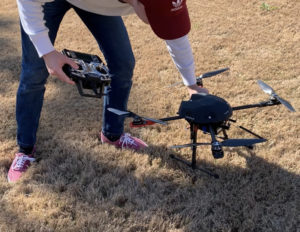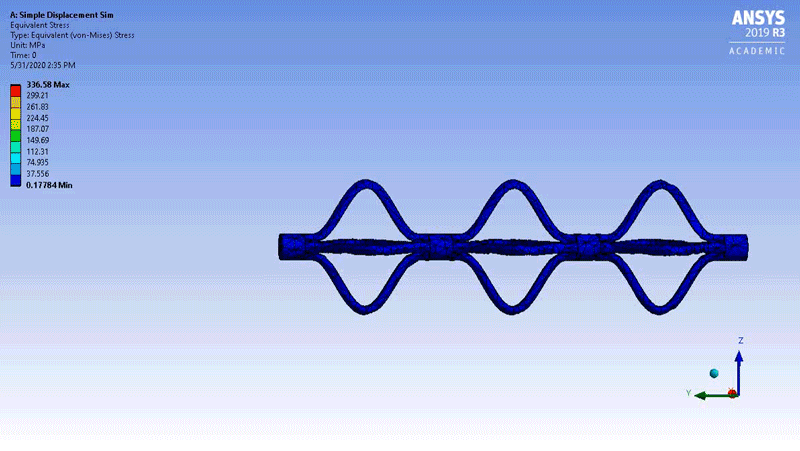Research Spotlights
- Home
- Research and Innovation
- Research Spotlights
Enhance Your Learning Experience
Mercer Engineering students can begin conducting research as early as their first year on campus under the supervision of Mercer’s highly talented faculty members. Take a look at the research spotlights below to learn about some of the research our faculty and students are working on right now.
Data-driven Sliding Mode Control for Pulses of Fluorescence in STED Microscopy Based on Förster Resonance Energy Transfer Pairs
Faculty: Dr. Makhin Thitsa
Student: Maison Clouatre
 Dynamic systems surround us: airplanes, automobiles, satellites, high-powered lasers, and mobile robots are notable examples of impactful dynamic systems. However, central to each of these is a common question: how can we make the system behave in a desirable way? For instance, how can maintain the altitude of an airplane or modify the orbit of a satellite? The area of mathematics and engineering that answers these questions is known as control theory.
Dynamic systems surround us: airplanes, automobiles, satellites, high-powered lasers, and mobile robots are notable examples of impactful dynamic systems. However, central to each of these is a common question: how can we make the system behave in a desirable way? For instance, how can maintain the altitude of an airplane or modify the orbit of a satellite? The area of mathematics and engineering that answers these questions is known as control theory.
Traditionally, an engineer would need to write down a mathematical model in order to derive what is known as a “control law”—a set of actions that modify the behavior of a given dynamic system. However, in this work we are developing model-free control algorithms. These techniques use tools from signal processing and data-science to quickly infer a given system’s dynamics from data alone. Then, these data-driven models are used to make control decisions. So far, the Thitsa Laboratory has applied these techniques to laser microscope systems and unmanned aerial vehicles.
Model-Free Acrobatic Control of Quadrotor UAVs
Developing Anti-congestion Algorithms for Diverging Diamond Interchanges
Faculty: Dr. Makhin Thitsa
Students: Maison Clouatre, Tam Hoang, Kenneth Montross, William Munsey, Ethan Perfect, Ebonye Smith, Eric Wiley
 Dr. Thitsa and her team of 7 research students are working on developing anti-congestion algorithms for diverging diamond interchanges. This project is funded by Georgia Department of Transportation, and Dr. Thitsa’s team is collaborating with a team of faculty and students from the Georgia Institute of Technology on this project. Diverging Diamond Interchanges (DDIs) are relatively new interchange designs that move traffic to the opposite side of the road at a freeway underpass or overpass, allowing vehicles to enter and exit the freeway via unimpeded left-hand turns. Since the concept of DDI itself is relatively new, research is needed on how to synthesize traffic control algorithms which coordinate the DDIs with the surroundings and respond well to changes in traffic demand. In this project, they are developing a data-driven, model-free approach to optimize the coordinated control of DDIs with neighboring intersections and freeway traffic control devices such as ramp meters.
Dr. Thitsa and her team of 7 research students are working on developing anti-congestion algorithms for diverging diamond interchanges. This project is funded by Georgia Department of Transportation, and Dr. Thitsa’s team is collaborating with a team of faculty and students from the Georgia Institute of Technology on this project. Diverging Diamond Interchanges (DDIs) are relatively new interchange designs that move traffic to the opposite side of the road at a freeway underpass or overpass, allowing vehicles to enter and exit the freeway via unimpeded left-hand turns. Since the concept of DDI itself is relatively new, research is needed on how to synthesize traffic control algorithms which coordinate the DDIs with the surroundings and respond well to changes in traffic demand. In this project, they are developing a data-driven, model-free approach to optimize the coordinated control of DDIs with neighboring intersections and freeway traffic control devices such as ramp meters.
Enhancing Epoxy Mechanical Properties by Glass Beads and Alumina Nanoparticles Additions
Faculty: Dr. Dorina M. Mihut, Dr. Arash Afshar, Dr. Alireza Sarvestani
Students: Gregory Baker, Nicholas Cordista, Connor Reed, Smith Pierce
Epoxy based composite materials are widely used in many fields including aerospace, automotive industry, and marine applications due to their good mechanical properties and low weight. The current research is investigating the effects of using glass beads micron size particles (9-13 micrometer) or alumina nanometer size particles (50 nm) as epoxy matrix reinforcements on the mechanical properties. Samples were produces using 0, 5, 10, and 15 % glass beads or similar percentages alumina nanoparticles that were well dispersed in the epoxy matrix. The degree of dispersion was evaluated using the Scanning Electron Microscopy (SEM). Some of the samples were then exposed to standardized accelerated weathering tests (cycles of UV radiation, high temperature, and moisture) using a Q-Lab QUV equipment. The effects of the glass beads and alumina nanoparticles epoxy embedment was explored by conducting standardized flexural tests (Mark-10 tensile testing equipment) and abrasion tests (Taber abrasion tester equipment). Similar tests were performed on samples exposed to harsh environmental conditions. Different models were developed to theoretically describe the mechanical behavior of the epoxy composites. It was observed that flexural strength performance was not enhanced by the introduction of glass beads or alumina nanoparticles. However, the abrasion resistance was improved by using both materials with higher improvement observed in the case of alumina nanoparticles.
Water Purification and Antibacterial Effects of Metallic Nanoparticles Deposited Using DC High Vacuum Magnetron Sputtering on Filtering Materials
Faculty: Dr. Dorina Mihut, Dr. Laura Lackey, Dr. Stephen Hill
Students: Khang Le, Ciara Winfield, Ronaldo Trento
Water and water purification is an important problem that is confronting our generation at a global level. Our current research is testing the antibacterial effects of Silver, Copper, Titanium, Zirconium and Aluminum metallic nanoparticles deposited on microsize filtration materials. The DC High Vacuum Magnetron Sputtering Equipment was used for the deposition of metallic nanoparticles. The thickness of the coatings was in-situ monitored using a quartz crystal microbalance and ex-situ evaluated using a profilometer. The chemical composition of the structures was characterized using the X-Ray diffraction analysis and their surface morphology was investigated using digital optical microscopy. Each metallic material was deposited on 3M filter paper with the respective thickness of 30 nm and 300 nm. The antibacterial effect was tested were using mBlue-E.Coli 24 media, the membrane filtering technique, and an incubator which was set at 35 Celsius degrees, according to standardized methods for the examination of water and wastewater. The testing media containing the bacterial samples was contaminated water collected from the wastewater basins. The water was initially tested for the bacterial content as collected and then exposed to metallic deposited filtering materials; the remaining targeted bacteria was quantified. The antibacterial effects of metallic nanoparticles were observed and analyzed. Deactivation rates for fecal coliform and Escherichia coli were measured with varying metallic thickness coatings. Atomic absorption spectroscopy would be used for quantitative determination of metallic nanoparticles in the testing media. In conclusion, all metallic nanoparticles showed a good adhesion at microscopic level to water filter paper as observed by digital microscopy examination. Titanium nanoparticles show no antibacterial effect because there was no change in time evolution of E. Coli and Total Coliforms for the control and titanium coated samples. Finally, it was observed that over time, silver and copper nanoparticles coated filters gradually removed both E. Coli and Total Coliforms.
Antibacterial Performance of Copper Coated Filter Papers and Low DC Electrical Currents Applied to Metallic Coated Structures
Faculty: Dr. Dorina Mihut, Dr. Arash Afshar, Dr. Laura Lackey, Dr. Stephen Hill
Students: Khang Le, Ryan Partolan, Jordan Hughes, Gregory Baker, Darren Pickren
The research is investigating the combined antibacterial effects obtained by using copper thin films on water filter papers in conjunction with low DC electrical powers applied to metallic coated structures for wastewater treatment. It is also investigating the antibacterial effect of ultrasonic agitation of silver coated structures. High vacuum magnetron sputtering technique was used to deposit copper thin films on water filter papers and the resulted structures were conductive. The morphology, distribution and adherence of metallic thin films to filter fibers were examined using digital optical microscopy and Scanning Electron Microscopy (SEM). The coated structures were effectively acting against common types of wastewater bacteria (e.g. Escherichia coli and other coliforms). The water containing bacteria samples was collected from local basins and the antibacterial effects were characterized using the standardized membrane filtering technique for water examination. Wastewater was tested for the bacterial content before and after the exposure to uncoated, metallic coated filter fibers, and to electrically activated coated filter fibers. Higher antibacterial effects resulted by applying electricity to the metalized fibers and increasing the electrical power enhanced the antibacterial performance. Accordingly, shorter exposure times were required to deactivate bacteria from the contaminated water. Higher antibacterial effects were also obtained for ultrasonically agitated copper coated structures.
Evaluation of 3D Printing Modalities for Fabrication of Biliary Stents
Faculty: Dr. Joanna Thomas
Students: Amanda Cimino, Claire Flippin

The purpose of pancreatic and biliary stents is to alleviate obstructed ducts in the hepatobiliary system. Stents are often required to treat biliary or pancreatic leaks, decrease the risk of post-ERCP pancreatitis (Pfau, 2013), or mitigate strictures due to inflammatory diseases of the ducts such as primary sclerosing cholangitis. It is crucial to ensure that bile, the secreted fluid in the hepatobiliary system, is able to flow efficiently, since it plays roles in digestion, circulation, and elimination within the bile ducts (Banales, 2019). Current pancreatic and biliary stents are commonly constructed from plastic (PSs, composed of plastic polymers) or metal (self-expandable metallic stents, or SEMS). Characteristics of these materials and stent design stipulate the properties of the stents, including diameter, length, flexibility, and biocompatibility.
A substantial barrier to bringing new biliary stents to market is pre-clinical R & D costs. Fig. 3 outlines the pathway from development through FDA approval. Minimizing the time spent on research and development can yield savings that could be passed on to patients. With the increased availability and reduction in purchase price for 3D printers, we believe fabricating stent prototypes with 3D printers could reduce the time needed to evaluate stent designs. For this study, we established the capabilities of two types of 3D printing, fused deposition manufacturing (FDM) and stereolithography (SLA), to achieve the resolution needed with appropriate material(s) for a biliary stent.
3D Printed Model of Extrahepatic Biliary Ducts for Stent Prototype Testing
Faculty: Dr. Joanna Thomas
Students: Robyn Guru, Leia Troop
Bile is produced in the liver and drains through the bile ducts into the small intestine where it aids in digestion. Several inflammatory conditions of the bile ducts, including primary sclerosing cholangitis, cause strictures that prevent drainage of bile. Treatments for inflamed or clogged ducts include plastic or self-expanding metal stents (SEMs) that are inserted in the bile ducts to re-establish bile flow.
The focus of this study was identifying 3D printers with the capacity to reliably fabricate models of the extrahepatic bile ducts (EHBD). 3D printing is a relatively inexpensive and timely means to fabricate parts and models. A 3D printed model of the bile ducts will enable rapid evaluation of custom biliary stent designs for patients with anatomic anomalies or extensive strictures.
Photopolymer Suitability for a 3D Printed Model of the Bile Ducts
Faculty: Dr. Joanna Thomas
Students: Nicholas Faist, Leia Troop
Efficient and accurate in vitro testing of biomedical device prototypes, in lieu of large animal studies can decrease the research and development costs of bringing a new device to market [1]. Work in our lab is focused on fabricating an improved in vitro testing system for biliary stents. These stents are inserted by gastroenterologists to restore bile draining from the liver when patients have conditions that acutely or chronically impede bile flow through the extrahepatic bile ducts (EHBD) to the small intestine.
An anatomically accurate model of the bile ducts will enable rapid evaluation of novel and/or custom biliary stent designs. 3D printing is a relatively inexpensive and timely means to fabricate parts and models. A 3D printed model must be elastic, pliable, and unaffected by long term contact with bile to be suitable for an in vitro stent testing system. A growing number of photopolymers with a variety of mechanical characteristics are commercially available for use in stereolithographic (SLA) 3D printers. In this study we evaluated the mechanical properities and absorption capacities of 3D printed samples of Formlabs Elastic, Flexible and Durable resins that were exposed to water, saline, or bile at 37C for 72 hours.